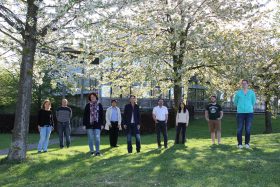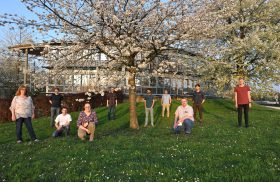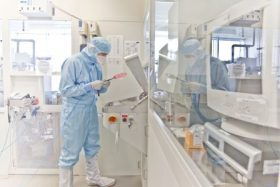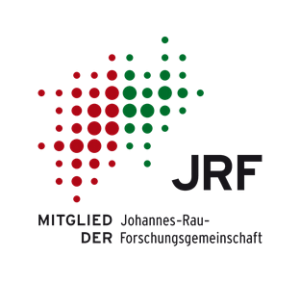Operating a clean-room in the time of COVID-19
It is has been a long tradition at AMO to take a group picture in front of the blossoming cherry trees outside AMO’s building. This spring the picture was taken in shifts, with a 2m-distance between people – like any other activity at AMO since middle March 2020.


“We have been early aware of the gravity of the situation, and we knew we had to react quickly and efficiently if we wanted to ensure the safety of our employees and maintain a certain level of operability”, says Max Lemme, Director of AMO. Already by early March, trips and in-house seminars were canceled, project meetings were moved to video-conferencing, and everyone was encouraged to take vacation or to work from home whenever possible, to reduce the people density at AMO.
However, AMO is a nanotechnology company, and the heart of a nanotechnology company is its clean room. And this is no work that can be performed remotely. AMO operates a 400 m2 clean room equipped with air-filtering systems of the highest standards, but neither this, nor the protective clothing used there offer an effective shield against SARS-CoV-2. Since March 17, the number of people allowed simultaneously in AMO’s clean room has been limited to six, to ensure that a 2 m distance can be maintained at any time. To partially compensate for this limitation and guarantee enough usability, the opening hours of the clean room have been extended from 7:00 to 23:00, seven days a week.

“We quickly set up a new booking system for clean room access, collecting suggestions from everyone working there – students, scientists, and technicians – to guarantee the maximum operability given the current constraints”, says Caroline Porschatis, process engineer at AMO. “No one is forced to work on weekends or in the night, but stretching the opening hours gives us more flexibility. In any case, for safety reasons it is necessary that at least two people are present in the clean room at the same time. If someone cannot find a “buddy” for a shift, that shift has to be skipped.”
The new booking system has been the basis for the rigorous shift-scheme in place since March 27. Since then, each employee has been assigned to a fixed shift and is not allowed to work at AMO outside that time. “The purpose of these measures is to avoid having to shut down the entire plant in the event of a corona infection”, says Hebert Kleinjans, head of the Technology Transfer at AMO. “In the unfortunate case that someone is infected, only a single shift will have to stay in quarantine, not the whole company”. The allocation of the shifts followed as far as possible personal preferences, while making sure that in each shift there are both a very experienced employee and someone with first-aid training.
Working in the offices has also been forbidden, except for a very few exceptions. The new rule is that every task that can be done in home-office must be also performed there. The open-space offices at AMO have suddenly become very still. “The situation is far from optimal”, says Jens Bolten, leader of AMO’s Nanostructuring group, “but in many respects, we are better off than many other labs that have been shut down completely. We’re operational, and this allows us also to help project partners that are in more difficult situations.”
All new measures taken at AMO aim at ensuring that a safety distance of 2 meters is maintained in every direct contact. “What applies in the street must apply even more in closed rooms”, says Max Lemme. “Thanks to the constructive support of everyone at AMO and of my research group at the Chair of Electronic Devices at RWTH Aachen University, which also uses AMO‘s clean room, we have been able to implement a regulation that drastically minimizes personal contact at work in a very short time. This has allowed us to continue our research projects almost without delay, as people have started to carry out office tasks like data analysis, experiment planning or literature studies from home.” Michael Hornung, Managing Director at AMO adds: “On average, we have managed to reduce working time in the office to below 5%, including the administration. The current situation is a serious test, but it shows how flexible and cohesive AMO can be. I am very proud of everyone.”




